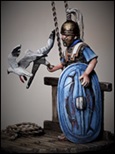Modelling
Painting style
9 posts
• Page 1 of 1
My painting style for the past one year or so has been the same. I put on the base colours, then I wash the whole mini, and then highlight it, with 2-4 layers, depending on what colour or part I'm painting, plus stuff like dry brushing when possible, small details like buttons etc. It's a simple but effective method, but I don't know how to take it to the "next level". What can I do to further improve at this point, beyond just being more accurate? Any tips are most welcome. Thanks in advance!
-
Bendy_Straw

- Posts: 98
- Member since:
05 Dec 2020, 13:59
I would propose to look into the "Work in Progress" section. There you can find a lot of step by step stories, where you can choose what to adapt. 

-

MABO
 Supporting Member (Gold)
Supporting Member (Gold) - Posts: 9146
- Member since:
12 May 2008, 18:01
I use the 'Jackson Pollock' style of painting miniatures. EG I stand about 5 metres away & hurl paint at them. Sometimes, I close my eyes when doing this.....as you can probably tell from my efforts. 
More seriously, this book (though intended for larger scales) proved very useful:
https://www.bookdepository.com/Painting ... 048&sr=1-1
I hope this helps.
donald
More seriously, this book (though intended for larger scales) proved very useful:
https://www.bookdepository.com/Painting ... 048&sr=1-1
I hope this helps.
donald
-

Ochoin
- Posts: 2402
- Member since:
16 Jan 2010, 04:00
Nothing wrong with your style of painting. If it works and looks good, everything is ok. Look at your minis and find out, which part you are the least satisfied with. Then you can try different techniques to improve these parts. I recommend youtube-tutorials for this. In my case, I always (and still) want to improve on the skin. So I tried different techniques to achieve or at least get closer to the wanted results. By doing this, you will automatically find out and learn new techniques that can be adapted to other sections of the mini to improve it.
-

Ben90

- Posts: 1509
- Member since:
28 Apr 2011, 23:32
I think the answer changes depending on what you are trying to achieve. Is it large formations that will look good or at least passable on a tabletop? Is it for a diorama? An individual figure? That answer will determine your potential approach.
It would take me decades to crank out the units that we see from Bill Slavin and desparaferro and others because I have limited time to paint and I like to try to produce one outstanding figure for duels.
It would take me decades to crank out the units that we see from Bill Slavin and desparaferro and others because I have limited time to paint and I like to try to produce one outstanding figure for duels.
-

Bluefalchion
- Posts: 3575
- Member since:
23 Dec 2010, 07:57
But for me, the test of a really great figure is the face. You can paint it with a base coat of flesh and give it a sepia wash and it will look decent, but a truly excellent face has the hint of different colors in different places. Dark brown shadows under the eyebrows, more reddish near the cheeks, greenish-brown (very thinned down) around the places normally shaved on a clean-shaven figure.
I rarely do eyes because most people have their eyes at least half closed at all times and a big old white eyeball poking out just does not look natural. But once you have added the very thinned down colors mentioned above, you can go back in with some more flesh color to re-emphasize the lips, chin, brows, cheeks, nose, and even eyelids.
I rarely do eyes because most people have their eyes at least half closed at all times and a big old white eyeball poking out just does not look natural. But once you have added the very thinned down colors mentioned above, you can go back in with some more flesh color to re-emphasize the lips, chin, brows, cheeks, nose, and even eyelids.
-

Bluefalchion
- Posts: 3575
- Member since:
23 Dec 2010, 07:57
Help keep the forum online!
or become a supporting member
I think to go next level you simply add more granulations of detail, the more gradual and subtle the transitions in colour, the better it looks. One of the limiting issues in painting 1/72 can be the surface areas are so fine that it's quite tricky to control for myself.
@Bluefalchion - you've reminded me of using different colours of glazes to add depth to faces - I'm thinking of a reddish brown glaze to make shadows near the cheeks, great idea!
Have you considered alternative styles as well? I'm quite a fan of Blanchitsu - rather than going more realistic you can go more stylised. I think exploring different styles you're not used to, just as experiments will also help your painting level. There's also non-metallic-metal, and I only do utilise it if I'm trying to drive myself nuts, but it can be a lot of fun.
@Bluefalchion - you've reminded me of using different colours of glazes to add depth to faces - I'm thinking of a reddish brown glaze to make shadows near the cheeks, great idea!
Have you considered alternative styles as well? I'm quite a fan of Blanchitsu - rather than going more realistic you can go more stylised. I think exploring different styles you're not used to, just as experiments will also help your painting level. There's also non-metallic-metal, and I only do utilise it if I'm trying to drive myself nuts, but it can be a lot of fun.
-

CliosPaintingBench
- Posts: 800
- Member since:
14 Jan 2020, 06:46
Excellent ideas that I will use.
Here is a problem that I think many people might have, which is how to keep the small brushes for detailing in shape to do the job? Another way of putting the question is how long can I expect my detailing brushes to hold up?
Here is a problem that I think many people might have, which is how to keep the small brushes for detailing in shape to do the job? Another way of putting the question is how long can I expect my detailing brushes to hold up?
-
Santi Pérez likes this post. •
- Reply
-
fpt

- Posts: 18
- Member since:
18 Jan 2014, 06:07
I found that a wet palette helped improve my painting, I too used to block,wash and highlight but now mix my shades in the palette and use very little washing.
There are numerous tutorials on YouTube on using them and how to make them, l bought the Army Painter version and am very happy with it.
There are numerous tutorials on YouTube on using them and how to make them, l bought the Army Painter version and am very happy with it.
-
Londoncopper

- Posts: 66
- Member since:
01 Nov 2014, 14:04
9 posts
• Page 1 of 1
